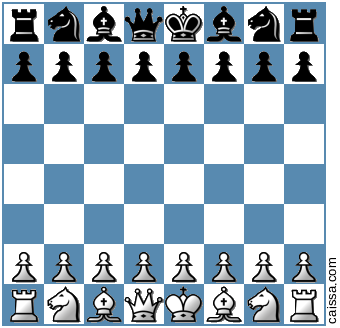|
|
Viewer |
|
|
|---|

| D91 Gruenfeld (Bg5) |
| Gruenfeld Defense: Three Knights Variation. Petrosian System |
| Emanuel Lasker vs Mikhail Botvinnik, 1936 |
| 1/2, 45 moves ("(Notes by Alekhine)") |
|
|
|
[Event "Nottingham"] [Site "Nottingham"] [Date "1936.??.??"] [EventDate "?"] [Round "?"] [Result "1/2-1/2"] [White "Emanuel Lasker"] [Black "Mikhail Botvinnik"] [ECO "D91"] [WhiteElo "?"] [BlackElo "?"] [PlyCount "87"] 1. d4 {Notes by Alekhine} Nf6 2. c4 g6 3. Nc3 d5 4. Nf3 Bg7 5. Bg5 {The more usual 5 e3 gives White only a very slight positional advantage. As he plays, he allows his opponent to obtain the advantage of the two bishops, which, however, is not easy to exploit, since Black cannot without taking chances transform the game into an open one.} Ne4 6. cxd5 Nxg5 7. Nxg5 e6 8. Nf3 exd5 9. e3 O-O 10. Be2 {The game, up to the 20th move, develops quite logically, and is easy to understand. White by starting the "minority attack" on the Q side, usual in this kind of position, finally (on the 21st move) compels Black to play b5 after which both sides get strong points at respectively c4, and c5. The only chance for Black after that would be in open diagonals for his bishops through an advance on the other wing; but that advance makes his king's position unsafe, and allows White to force the exchange of queens before the bishops become dangerous. A well-played but rather a dull game is the result.} c6 11. O-O Qe7 {Preventing for the time being b4.} 12. a3 Be6 13. Rc1 Nd7 14. Ne1 {The knight aims at c5; but after Black's next cautious move the manoeuver will prove harmless.} Nb6 15. Nd3 Rad8 16. Nc5 Bc8 17. b4 {If 17 b3 (to prevent Nc4) Black could at once start a counter-attack with 17...f5.} Nc4 18. Nb1 b6 19. Nb3 Ba6 20. Re1 {A mistake would be 20 Nb1d2 for then Nb2 21 Qe1 Nd3.} Rfe8 21. N1d2 b5 22. Ra1 Bc8 23. Bf1 {Preventing the promising sacrifice Nxe3, etc, - e.g., after 23 Nc5.} Qd6 24. Nc5 Re7 25. Ndb3 Rde8 26. Qc1 {Still preparing a4 which here would be premature on account of 26...bxa4 27 Rxa4? Nb2.} f5 27. Nd3 g5 28. Qc3 f4 {Black, as already mentioned, is practically obliged to force matters, since otherwise White would take the initiative with a4.} 29. exf4 gxf4 30. Rxe7 Rxe7 31. a4 a6 32. axb5 axb5 33. Ra8 Re8 34. Qc1 Rf8 35. Qd1 {Not of course 35 Nxf4? for then Bh6 followed by Qxb4.} Bf5 36. Rxf8+ Bxf8 37. Qh5 Qg6 {Otherwise-after 37...Bg6 38 Qg5-the pressure exerted by the White queen would become unpleasant.} 38. Qxg6+ hxg6 39. Nxf4 Bxb4 40. Bd3 Nd2 {This last chance to win is sufficiently parried by White's 43rd move.} 41. Nxd2 Bxd2 42. Bxf5 gxf5 43. Ne6 {!} Bc3 {Or 43...Kf7 44 Nd8+. Or 43...b4 44 Nc5. An easy draw in either case.} 44. Kf1 1/2-1/2 |
Game links and puns: www.chessgames.com
| | | zurück | | | | | Anfang | | | home | | |